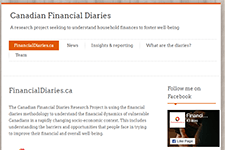Discover financial empowerment resources
Discover financial empowerment resources
The Canada Revenue Agency administers dozens of cash transfer programs that require an annual personal income tax return to establish eligibility. Approximately 10–12 percent of Canadians, however, do not file a return; as a result, they will not receive the benefits for which they are otherwise...

This report, 'The Perils of Living Paycheque to Paycheque: The relationship between income volatility and financial insecurity', examines the relationship between income instability and broader measures of financial well-being. This study makes use of a unique dataset that collected...

An emerging body of international literature is beginning to reveal a significant connection between financial capability metrics and personality, suggesting that what influences our financial well-being may be more nuanced than we previously thought. This report investigates how the inclusion...

The Canadian Financial Diaries Research Project is using the financial diaries methodology to understand the financial dynamics of vulnerable Canadians in a rapidly changing socio-economic context. This includes understanding the barriers and opportunities that people face in trying to improve...

An emerging body of international literature is beginning to reveal a significant connection between financial capability metrics and personality, suggesting that what influences our financial well-being may be more nuanced than we previously thought. This study investigates how the inclusion of...

This paper has been commissioned by Prosper Canada to develop and present a working model of the relationships between financial empowerment and poverty in Canada. It reviews published, international, English-language, academic and grey literature, as well as documents provided by Prosper...
This discussion paper responds to a request from ESDC to develop options for reforms to the Canada Education Savings Program and, more specifically to improve access to the Canada Learning Bond. It reviews individual and institutional challenges to participation in the current system and consider...
This paper contributes to the literature on the state of household finances in Canada by constructing new indicators using Canadian microdata based on Canadian and international literature. Using data from the Survey of Financial Security (1999, 2005 and 2012), and also the Canadian Financial...
Confused about how Canadian households are doing financially? Financial experts, policymakers, and media tell a conflicting story. What is really happening? This presentation is based on data from the Canadian Survey of Financial Capability in 2008 and 2014. It shows the state of Canadian financial...
This study aims to validate the results of a 2012 pilot study that developed a short instrument to measure financial capability, using national survey results as reference point. More importantly, this study also develops a numerical scoring system to provide respondents with a transparent and easy...
Recent commentary on the state of the average Canadian’s finances has been sharply divergent, as rosy conclusions clash with much more pessimistic takes. Which is right? From the perspective of income, the news is generally good. But consider assets, and the reality is...
There is a large and sophisticated industry of financial professionals available to give financial information and advice to Canadians who can afford their services, but Canadians with low or modest incomes and wealth lack the means to purchase that help. What’s more, sometimes mainstream...
Broadly speaking, there are few education and training policy measures designed with the needs of low-income working age adults in mind. The learn$ave demonstration project was launched in 2000 by Human Resources Development and Skills Development Canada (HRSDC) to test the effectiveness of...
This report quantifies the benefit of the ILA model through a return on investment calculation. Feedback from current partners of the ILA was also gathered in an attempt to reflect the strengths and weaknesses of the model in order to evaluate the potential of bringing these benefits to scale. This...
